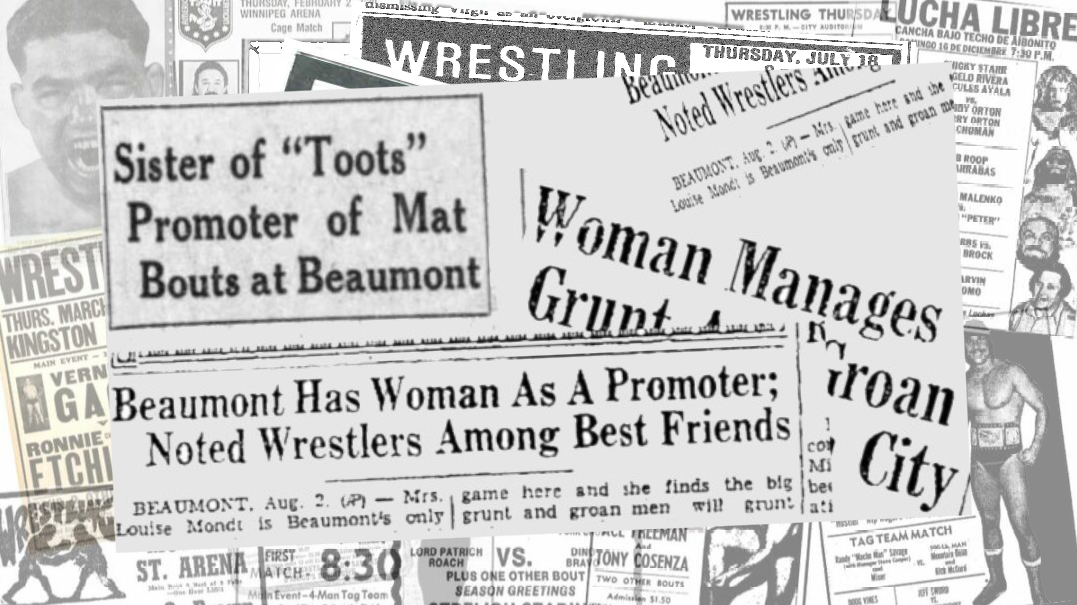Wrestling isn’t your normal 9-to-5 job. It’s a niche lifestyle that requires dedication, determination, and a dash of masochism. Because of that, the “business” can sometimes become the family business for a select few willing to endure the pain, loneliness, and long, hard miles on their body and North America’s pre-interstate roads.
Just ask the Harts, Funks, Armstrongs, Guerreros, Vachons, Baillargeons, McMahons, and so many more.
The Mondts are another familiar bond who struggled to navigate the treacherous landscape of wrestling and relationships as we’re about to lay bare.
For this installment of the Card Exam, we head 300 miles south of Paris, TX, to Beaumont, Texas, and some 20 years into the past from Mae Young, as we uncover the tale of Mrs. Louise Mondt, wrestling promoter — one of many women who preceded new WWE Hall of Fame inductee Lia Maivia, who was at times wrongly named the first female promoter.
April 9, 1935, Beaumont, Texas
- Young Joe Stecher d. Preacher Hogue
- Harry Finkelstein d. Nick Elitch (2-0, 47 minutes)
- Cowboy Luttrell d. George Hills by DQ (2-1, 59 minutes)
So, what do we know about Louise?
Louise Wilson was born in 1901 in Indiana. Not just a pretty face, she was a talented athlete like her husband, Art Mondt, and her brother-in-law, the well known Joe “Toots” Mondt. Never one to shy from the limelight (or a fight), Louise was heralded by the Sacramento Bee as an experienced boxer, having taken part in “several exhibitions” with Norman Selby — also known as the legendary “Kid McCoy.”
Louise and Art wed sometime around 1920 and originally settled in the Mondt’s hometown of Greely, Colorado, before eventually heading south to Texas by the start of the 1930s. The marriage appears to have been a shotgun-type affair, with Louise and Art the parents of Lavar Annette, born June 5, 1919, in Greely.
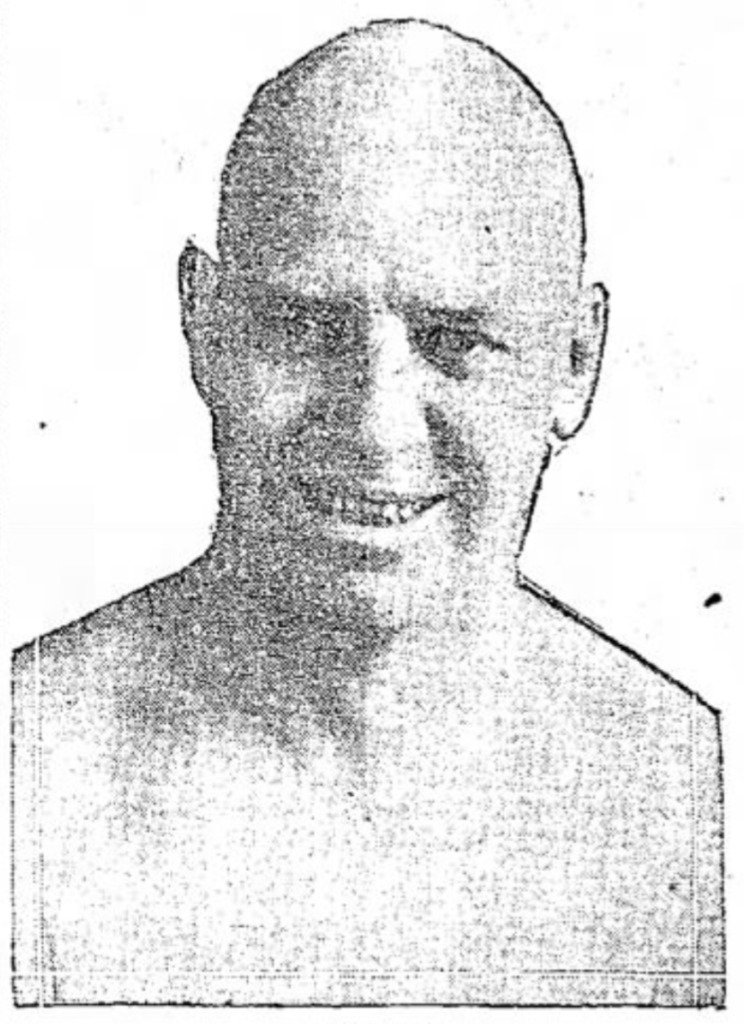
Arthur “Art” Mondt
Regardless of the nature of the marriage, by 1930, life was good for the Art Mondt family. He was a successful middleweight grappler in the region, settling in Dallas and accumulating titles and promotional interests in that period.
But a campaigning grappler couldn’t be the face of a promotion for many reasons. For starters, it would quickly lead to accusations of corruption and a fix to the press, competitors, and fans. But equally important was the inability to be in two places at once. With Art often tied up in the north of the state and Oklahoma wrestling, his interests in the southeastern city of Beaumont were in danger of neglect.
The city of Beaumont, east of Houston on Texas’s Gulf Coast, fell into Art Mondt’s lap due to the relocation of the city’s existing promoter, Bill Froelich. Froelich had decided to up-sticks some 60 miles east to Lake Charles, Louisiana, in 1932, giving the upstart Arthur a chance to emulate his brother Toots.
And that’s where Louise came in.
While only a Mondt by marriage, the fiery boxer-turned-mom did not shy away from a challenge and quickly took to the role of promoter and matchmaker for Beaumont like a fish to water, quickly establishing herself as a reliable, robust wrestling mind.
Louise booked and promoted in Beaumont for the better part of two-and-a-half years, running Tuesdays at the city’s National Guard Armory, with additional outdoor shows at the “open-air wrestling emporium on North Pearl.”
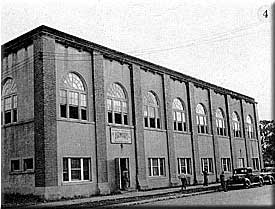
The National Guard Armory in Beaumont, Texas.
But as with anything associated with a Mondt, the Beaumont promotion was a headache.
The issues began immediately. While Froelich was the previous promoter, Art Mondt bought the wrestling rights from “Mr. Luther Wilson,” titular licensed boxing and wrestling promoter in Beaumont, and turned it over to his wife, L. Mondt.
The deal required Mondt to pay “L. Wilson” a sum of $100 for the rights, plus 5% of the gross receipts of Beaumont matches, until September 1, 1935.
Whether Luther Wilson was real and not a pseudonym for Louise Wilson is unknown. But the existence of Wilson and his very real license caused headaches for Mondt for many of the reasons I mentioned in the introduction — but mostly the sketchy idea that a wrestler was buying a promotion for his wife.
The situation reached a head when Art was forced to appear before an investigative subcommittee at the Texas House of Representatives on November 8, 1933. But the Mondts assuaged lawmakers, and Louise retained her hard-fought promoter’s license.

The Mondt’s appear in Austin for a hearing, November, 1933
The next two years for Louise were action-packed, with the National Guard Armory playing host to an impressive list of top talent, including the likes of the popular Man Mountain Dean and local favorite Clarence Luttrell — the Texas cowboy who would eventually tame the wilds of Florida as a wrestling market in the 1950s and ’60s.
She even used her connections with the boxing world to attract former fighters into the ring. One notable example was Jack League, a popular journeyman fighter with a nominal victory over Primo Carnera, jumping to wrestling against Ernie “Wildcat” Stevens on November 21, 1933.
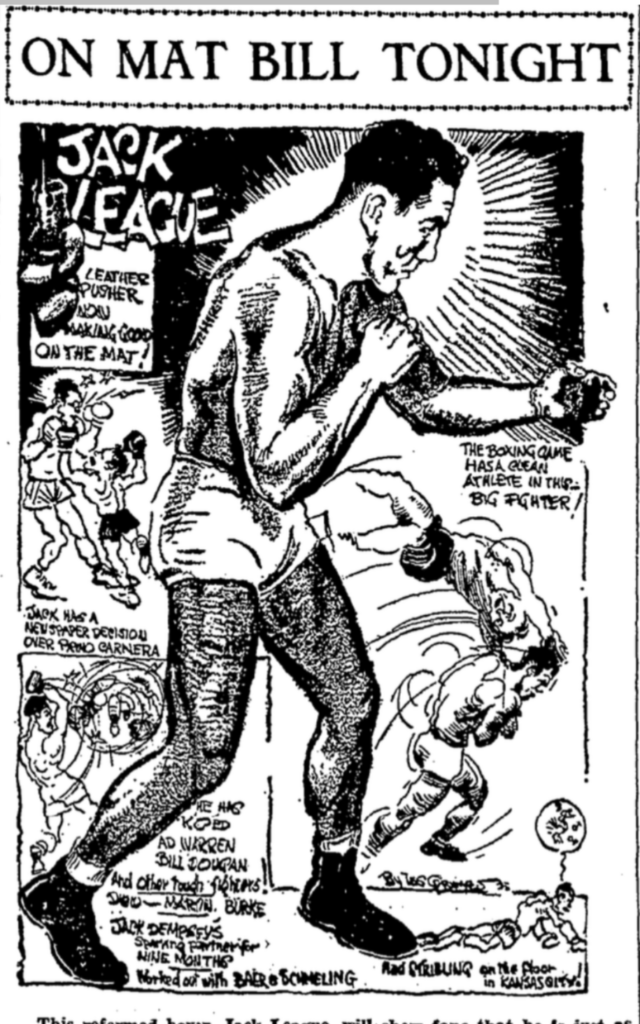
Jack League
But let’s jump forward to our card for the evening, April 9, 1935, at the previously mentioned “open-air wrestling emporium on North Pearl.”
The opening contest saw Young Joe Stecher of Cambridge, Massachusetts, defeat “Preacher” Hogue.
“Preacher” Hogue was an occasional nom de guerre of Murrell Hogue, a Texas-based grappler whose career spanned the better part of the ’30s but lacked the sort of standout moments that posterity requires for remembrance.
His opponent, “Young Joe Stecher,” on the other hand, could boast of a nearly 20-year in-ring career, most often under his real name, George Wilchester, and against major stars like Jim “Goon” Henry, Ed “Tarzan” White, Danny Dusek, the Zaharias bothers, and Paul Jones.
Our second contest saw Harry Finkelstein defeat Nick Elitch two falls to none in just 47 minutes.
Finkelstein was nicknamed the “Jewish Bad Boy” and was a hulking Jewish bruiser from Boston who graduated from the Beantown rings of Paul Bowser into the chaotic world of New York, grappling by 1935, finding himself under the thumb of Jack Pfefer as one of his “Golden Angels” some ten years later. Eventually, the industrious Finklestein would move into promotions and management in New York.
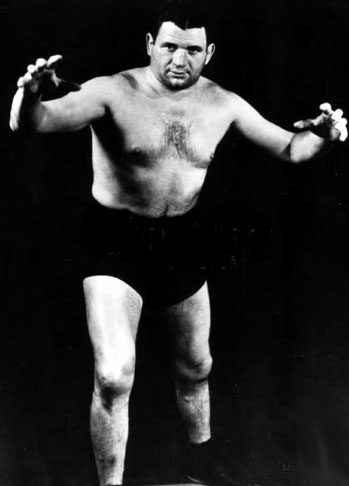
Harry Finkelstein
Interestingly, Finklestein was also one of the referees for the evening, with wrestler Benny Mathis given the duties for the second match.
Finklestein’s opponent, Nick Elitch, is an intriguing character. From what would become Yugoslavia, Elitch (real name Nedelco Ilitch) made a name for himself, crisscrossing the United States in the 1930s and ’40s — often on the winning side of the ledger. His speed, finesse, and Dalmatian good looks even landed him the brief ring name “Nick Londos” in Albuquerque in the late 1930s, which is no small honor!
Finally, the main event for the evening saw the popular local cowboy, Clarence Luttrell, defeat George Hill. I know very little about Hill, save that he had a long career working for many of the biggest promotions in the sport, including a run with the Southern heavyweight title later in 1935.
Cowboy Luttrell is famous for creating the Florida wrestling territory, but his story is far more interesting than just his office location.

Born in Jacksboro, Texas, Luttrell was a seasoned campaign in the American South, particularly in Texas, Louisiana, the Carolinas, and Georgia. But his claim to fame came in 1940 with a mix-up with an aged legend: former heavyweight boxing champ Jack Dempsey.
Dempsey, a special referee in a tag match in Atlanta, raised the ire of Luttrell, with the feisty Texan shoving Dempsey clear across the ring. Dempsey pushed back, with Luttrell landing a clumsy blow before the violence could be subdued.
A tough-talking cowboy, Luttrell thought he could more than handle the aged Dempsey, who by 1940 was 45 years of age and balding. But when the bout finally arrived on July 1, 1940, at Ponce De Leon Park in Atlanta, Dempsey had the last laugh.
“I’ve licked tougher guys than Jack Dempsey,” Luttrell bragged to a reporter after the fracas. “There’s never been a boxer who could beat a good wrestler. I want to be known as the guy who KO’d Dempsey.”
Despite years of ring rust and plenty of self-doubt, Dempsey made humiliatingly quick work of Luttrell, eventually knocking him clear through the ropes in the second round and the tough Texan being counted out.
Luttrell had made a name for himself for all the wrong reasons. But any press is good, and the kayoed cowboy would use that notoriety to aid his wrestling promotions.
Here’s that footage, courtesy of ESPN.
The final record card for Mondt’s promotion was just weeks later, on Tuesday, April 23, 1935. That card was another three-match affair, with Cowboy Luttrell taking on rival Jack O’Dell, Nick Condos taking on Finklestein, and another unnamed preliminary bout. There are no results.
By the end of 1935, both Louise and Arthur Mondt were gone from Texas wrestling. Whatever the cause of Louise’s abandonment of her Beaumont promotion, it’s evident that it played no small part in the breakdown of the Mondt marriage.
Arthur took the opportunity of the break to jump to Southern California, becoming a boxing and wrestling kingpin in San Bernadino, and later aligned with the Daro brothers in their Southern Californian wrestling kingdom.
It was likely Arthur who helped secure his brother Toots a position alongside the Daro brothers after he played no small part in the destruction of the wrestling scene in New York.
As for Louise, her story stayed in Texas, where she remained with daughter Lavar. As the ex-wife of a Mondt and a local promoter, you might expect his ex-wife Louise and daughter to enjoy a comfortable existence.
You’d be wrong.
Instead, Louise and Lavar were left in shared accommodation on Center Street in the city, as revealed in the September 1936 police report, with Louise being the victim of a $13 petty theft while she slept. Eventually, life would ease for the pair, moving to Silsbee, where Lavar would reside for decades.
While Art isn’t as well known as his brother Toots, he possessed many of the same skills as his famous brother: namely sound wrestling ability, impeccable comedic instincts, and abysmal management skills.
Toots’ hasty retreat from the Big Apple signaled the end of an era in New York wrestling. For over a decade, Mondt had stood at the summit of professional wrestling, a key cog in the Tammany Hall-esque machine that ruled the roost with spectacular results.
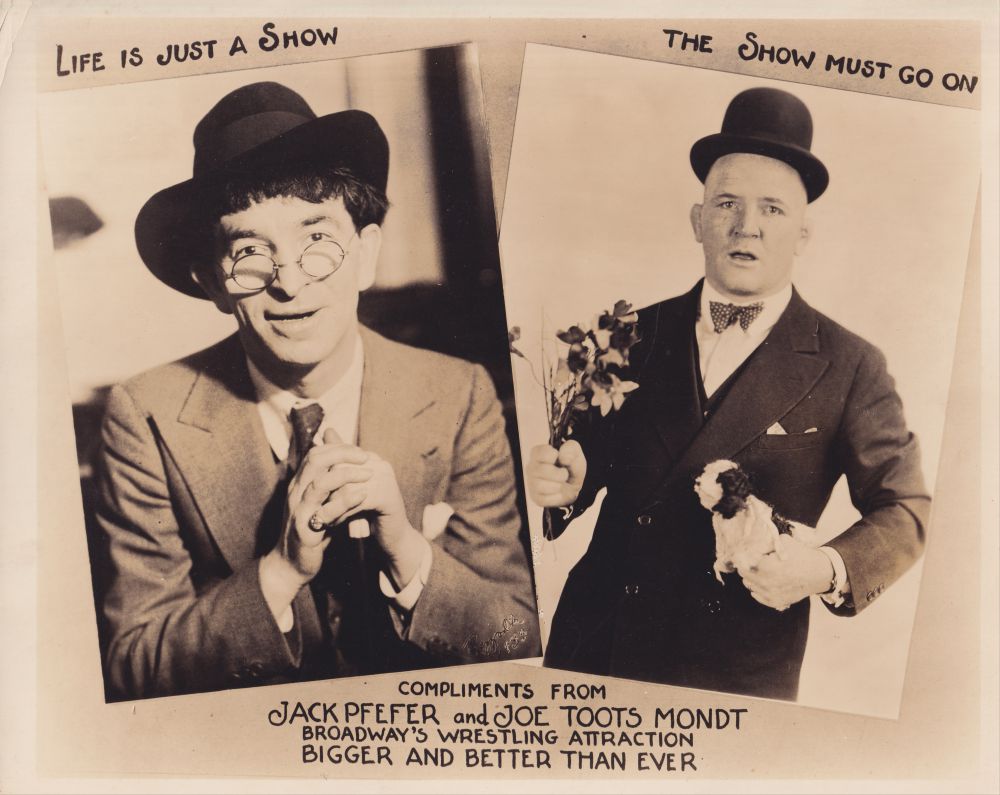
Jack Pfefer and Toots Mondt.
Absconding for the West Coast, Toots tried to minimize the damage to his reputation (by 1936 already rife with mismanagement, nonpayment, and NYSAC condemnation) with a hatchet job, faux-historical hit piece, Fall Guys by friendly journalist Marcus Griffin which managed to blame everyone — save Toots — for the decline of the sport.
On the coast, he joined his brother Art, who had already established a name in Southern California after beating a hasty retreat from Texas, his promotional interests, and Louise. There the two proceeded to make a hash of things, with Jack Daro and the Mondt brothers sued for back pay to $4,386 by a dozen wrestlers.
Eventually, Toots would escape creditors again, this time finding safety under the umbrella of Jack Pfefer (if only for a short time). But Arthur Mondt never told his side of the story — why he hit the road and ditched his wife and children to flop in California.
I guess he didn’t have Marcus Griffin’s number.
RELATED LINK
